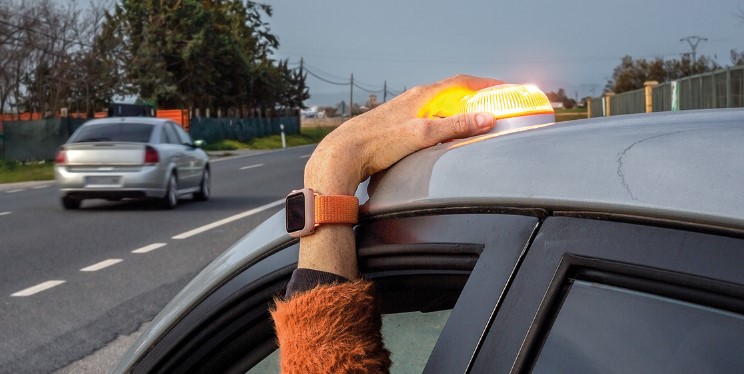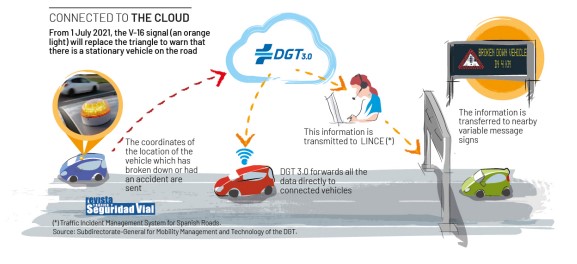
The V-16 hazard warning device has been in use since July 2021 and will become mandatory in Spain from January 1st 2026. It is an orange flashing light that replaces the warning triangles as a means to advise other drivers of a stationary vehicle on the road. When placed on top of the vehicle, it ensures maximum visibility to those drivers whilst also communicating its location to the DGT 3.0 platform, allowing other connected vehicles to be advised and electronic road signs to display the appropriate warnings.
Currently, when a vehicle broke down or was involved in an accident on motorways and dual carriageways, it has been mandatory for a reflective warning triangle to be placed alongside the road some 50 metres behind the stationary vehicle to warn oncoming drivers. On single carriageway roads, a second warning triangle must be placed 50 metres in front of the vehicle. This means that the driver or another occupant of that vehicle has to walk on foot to place the triangles, putting themselves at risk of being hit by another vehicle. In addition, adverse weather conditions such as rain and strong winds can knock over the triangles, making them effectively useless as a warning device.
Over the past five years, an average of 22 people a year have been killed after being hit by another vehicle when leaving their own transport, often to place the warning triangles in the road. Therefore, it was proposed to develop a more advanced system that would be easy to use and minimise the risks, resulting in the V-16 beacon project.
Real Decreto 159/2021 of March 16th 2021 which regulates emergency services on public roads, established that, from January 1st 2026, the driver of a vehicle immobilised on the road must provide a warning signal by using an amber light which must be placed as high as possible on the vehicle to ensure its visibility. In addition, the Dirección General del Tráfico (DGT) issued a resolution on November 30th 2021 which defined the protocol and format for sending data from V-16 devices to the National Access Point in accordance with a 2010 EU Directive on the deployment of intelligent transport systems.
The V-16 hazard warning device forms part of the DGT’s Road Safety Strategy 2030 which aims to reduce fatal and serious accidents by 50% by minimising the driving-related risks since it can be installed without the need to leave the vehicle. Since it emits a high intensity 360º light for at least 30 minutes, it also increases the visibility of the stationary vehicle on the road since it has the potential to be seen at a distance of up to 1,000 metres, compared to 100 metres with a physical warning triangle. The device also connects to the DGT 3.0 connected vehicle platform, providing information of its activation, deactivation and location every 100 seconds so that other drivers can be warned directly as well as through electronic message signs on the road.

The V-16 hazard warning device must be carried in the glove compartment of the vehicle to be accessible immediately in the event of a breakdown or accident. It must be fully charged and powered independently by a battery which guarantees its use for 18 months or by a rechargeable battery that can be charged by the vehicle itself. Connection to the DGT 3.0 platform is integrated into the device, so there is no need for an external device such as a mobile phone, whilst the cost of connectivity is included in the purchase price and guarantees a connection for a minimum 12 years so there are no additional fees to pay.
Only approved brands and models are valid, devices which has passed the certification process and comply with the provisions of Annex XI of Real Decreto 2822/1998 which approves general vehicles regulations, including signals. Click here for a direct link to the DGT website which lists the approved devices.
The V-16 hazard warning device will be the ONLY legal hazard pre-signalling device from January 1st 2026.
Click here for more information from DGT.es (PDF).

